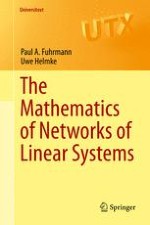2015 | OriginalPaper | Chapter
11. Synchronization and Consensus
Authors : Paul A. Fuhrmann, Uwe Helmke
Published in: The Mathematics of Networks of Linear Systems
Publisher: Springer International Publishing
Activate our intelligent search to find suitable subject content or patents.
Select sections of text to find matching patents with Artificial Intelligence. powered by
Select sections of text to find additional relevant content using AI-assisted search. powered by
